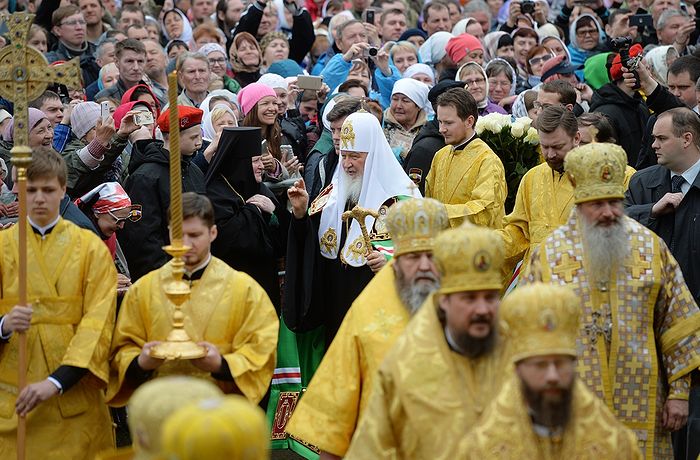From a
report at the Pravoslavie website:
With the blessing of His
Holiness Patriarch Kirill of Moscow, the Synodal Biblical-Theological
Commission has published a draft version of the Catechesis of the Russian Orthodox Church for
Church-wide discussion, reports patriarchia.ru.
The final section on the Russian Church’s attitude towards the non-Orthodox has
caused some consternation.
. . .
Concerns
have been raised about the final section, especially as it pertains to
ecumenical organizations and meetings. The document “Basic Principles of Attitude to the Non-Orthodox” maintains
that Russian representatives to bi- and multi-lateral discussions with other
Christian confessions have always unerringly maintained the purity of the
Orthodox faith (4.3), and moreover, quotes a Pan-Orthodox meeting in
Thessaloniki in 1998:
During Orthodox participation of many
decades in the ecumenical movement, Orthodoxy has never been betrayed by any
representative of a Local Orthodox Church. On the contrary, these
representatives have always been completely faithful and obedient to their
respective Church authorities, and acted in complete agreement with the
canonical rules, the Teaching of the Ecumenical Councils, the Church Fathers
and the Holy Tradition of the Orthodox Church (7.3)
Therefore
the document states that, “The Church condemns those who, by using inauthentic
information, deliberately distort the task of the Orthodox Church in her
witness before the non-Orthodox world and consciously slander the Church
authorities, accusing them of the ‘betrayal’ of Orthodoxy.” Such sowers of
temptation, according to the document, ought to be subjected to canonical
sanctions. The statement included from the Thessaloniki meeting refers not only
to schismatics, but also to “certain extremist groups within the local Orthodox
Churches,” who “[use] the theme of ecumenism” to criticize Church leadership,
“thus attempting to create divisions and schisms within the Church,” seemingly
accusing all who oppose Ecumenism as being among those who use “inauthentic
information” in the fight against it.
Not all accept the view that Orthodox
representatives have never, without exception, compromised any matter of
Orthodoxy at ecumenical gatherings and dialogues. Many prominent voices within
the Orthodox Church, including St.
Justin Popovich, Elder
Ephraim of Katounakia, St.
Paisios the Athonite, St.
Seraphim of Sobolev, Fr. Seraphim Rose, Metropolitan
Hierotheos (Vlachos), and many others have been very vocal about the
dangers posed by the Ecumenical movement, and following last year’s council on
Crete, entire Local Churches have raised the flag, including the Bulgarian
and Georgian
Churches.
The February 2016 joint declaration between
Pat. Kirill and Pope Francis also garnered criticism. For instance, Fr.
George Maximov wrote that the document contains expressions “which are by
no means indisputable, and sometimes erroneous,” and Dcn.
Vladimir Vasilik wrote, “The joint declaration signed by the Pope and the
Patriarch leaves one with mixed feelings… there are a whole series of
formulations in this document that evoke well-founded anxiety… this meeting was
in many points unsatisfactory.” Fr. George also wrote a critical
response to the September 2016 gifting of a particle of the relics of St.
Seraphim of Sarov to the Pope of Rome.
Most recently, Archpriest Artemy Skripkin
of the Tikhvin Diocese has announced that he is invoking Canon 15 of the First-Second
Council in order to cease commemoration of Pat. Kirill, as well as Metropolitan
Barsanuphius of St. Petersburg and Ladoga, and his own hierarch, Bishop
Mistislav of Tikhvin, after unsuccessful attempts to receive clarification on a
recent statement from Pat. Kirill at a children’s hospital in which he said, “I
know that there are Christians and Muslims here, each addressing one and the
same Creator God, and in response to this we receive real help from God.”
Canon 15 of the First-Second Council, held in 861 in
Constantinople under the chairmanship of St. Photios the Great, states that if
a bishop openly declares a heresy previously condemned, a priest may cease to
commemorate him without ecclesiastical sanction. This “walling off” is not
considered a schism, but the same canon states that if a priest ceases to
commemorate a bishop over a heresy not
previously condemned, then his action is considered one of schism.
Having received no explanations over the
course of two months, Fr. Artemy writes that he is ceasing commemoration of and
thereby breaking communion with the three bishops, and any others who agree
with the patriarch’s words, and that the decrees and punishments of the
mentioned bishops are accounted as nothing to him.
The full text of the draft catechesis can
be found at theolcom.ru, and reviews are being accepted at catechism@theolcom.ru until November 1.
Source: http://www.pravoslavie.ru/english/105386.htm,
opened 28 July 2017
--
Holy
Ælfred the Great, King of England, South Patron, pray for us sinners at the Souð!
Anathema
to the Union!





